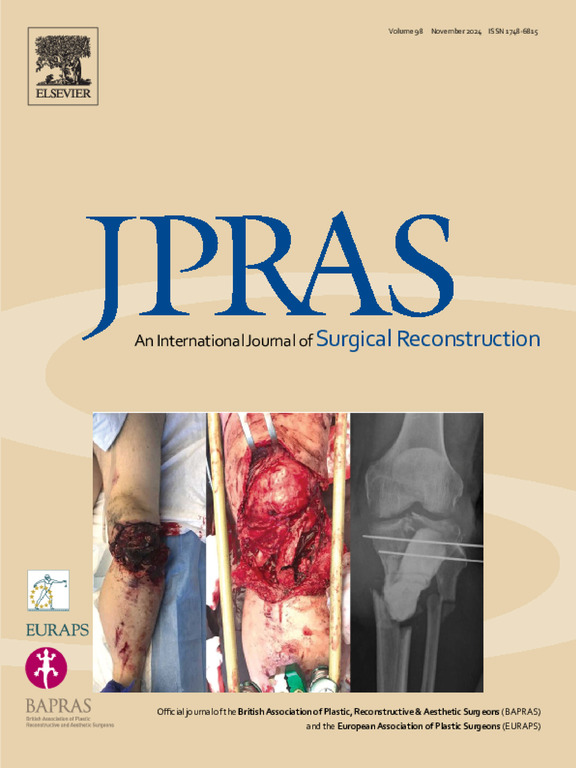The role of antibiotics-impregnated mesh in preventing capsular contracture recurrence: A single-surgeon experience
IF 2.4
3区 医学
Q2 SURGERY
Journal of Plastic Reconstructive and Aesthetic Surgery
Pub Date : 2025-09-23
DOI:10.1016/j.bjps.2025.09.018
引用次数: 0
Abstract
Background
Capsular contracture remains the leading cause of revision surgery following implant-based breast augmentation, with growing evidence suggesting that biofilm may play a key role in its formation. This study aimed to evaluate the effectiveness of using an antibacterial envelope in reducing the recurrence of capsular contracture.
Methods
This retrospective case series included patients presented with capsular contracture. All patients underwent capsulectomy with implant replacement and placement of an antibiotic absorbable mesh placed anterior to the implant. Demographic information, implant data, and postoperative outcomes were collected. Patients with less than 24 months of follow-up were excluded from the study. Descriptive analysis was performed using Microsoft Excel.
Results
A total of 18 patients (31 breasts) were included in this study. The mean age at the presentation of capsular contracture was 50.9 ± 9.0 years, and the mean duration since the placement of the original implant was 166.1 months. Mean postoperative follow-up was 54.7 months. All patients had Baker grade III or IV capsular contracture at presentation. Following capsulectomy with mesh placement, recurrence of capsular contracture occurred in five breasts (16.1%). Immediate postoperative complications included one hematoma that was treated with reoperation.
Conclusions
Our findings highlight the safe profile and potential use of antibiotic-impregnated mesh in reducing the capsular contracture recurrence. Further investigation is warranted to assess the outcomes and validate this technique for managing capsular contracture.
抗生素浸渍补片在预防包膜挛缩复发中的作用:一个外科医生的经验。
背景:囊膜挛缩仍然是假体隆胸后翻修手术的主要原因,越来越多的证据表明生物膜可能在其形成中起关键作用。本研究旨在评估抗菌包膜在减少包膜挛缩复发中的有效性。方法:回顾性分析包膜挛缩患者。所有患者均行假体置换囊切除术,并在假体前方放置抗生素可吸收网片。收集人口统计信息、种植体数据和术后结果。随访时间少于24个月的患者被排除在研究之外。采用Microsoft Excel进行描述性分析。结果:本研究共纳入18例患者(31个乳房)。出现囊挛缩的平均年龄为50.9±9.0岁,自植入原种植体以来的平均持续时间为166.1个月。术后平均随访54.7个月。所有患者在就诊时均有Baker III级或IV级包膜挛缩。术后5例(16.1%)乳房出现包膜挛缩复发。术后直接并发症包括一例血肿,需再次手术治疗。结论:我们的研究结果强调了抗生素浸渍补片在减少包膜挛缩复发方面的安全性和潜在应用。进一步的研究是必要的,以评估结果和验证这种技术治疗包膜挛缩。
本文章由计算机程序翻译,如有差异,请以英文原文为准。
求助全文
约1分钟内获得全文
求助全文
来源期刊
CiteScore
3.10
自引率
11.10%
发文量
578
审稿时长
3.5 months
期刊介绍:
JPRAS An International Journal of Surgical Reconstruction is one of the world''s leading international journals, covering all the reconstructive and aesthetic aspects of plastic surgery.
The journal presents the latest surgical procedures with audit and outcome studies of new and established techniques in plastic surgery including: cleft lip and palate and other heads and neck surgery, hand surgery, lower limb trauma, burns, skin cancer, breast surgery and aesthetic surgery.

 求助内容:
求助内容: 应助结果提醒方式:
应助结果提醒方式:


